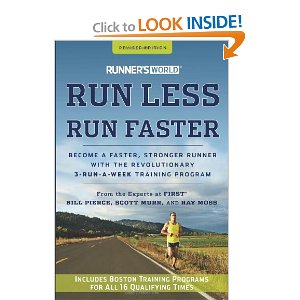 I have established elsewhere I am not a very fast runner. However, I am obsessed with reading about running and trying out new training programs. I purchased this book about a month and a half ago, and so far I am very impressed with the methodology.
I have established elsewhere I am not a very fast runner. However, I am obsessed with reading about running and trying out new training programs. I purchased this book about a month and a half ago, and so far I am very impressed with the methodology.
First of all, the authors of “Run Less, Run Faster: Become a Faster, Stronger Runner with the Revolutionary 3-Run-a-Week Training Program” are bona-fide scientists with the Furman Institute of Running and Scientific Training (FIRST). Their focus is on injury prevention due to over-training. The premise of the book is that each run should have a purpose: to make you faster.
This methodology is not about jogging for the sake of jogging but focusing your training on three runs:
- Track Repeats (interval training),
- Tempo (running a bit slower than your 5k pace for a sustained distance)
- Long Runs (run at a faster pace than most other training programs I have used but still slower than your tempo runs)
In addition to “only” running three times a week, you have to do additional cross training two days a week. The things that count as cross training are rowing, swimming, and cycling.
The reason I put “only” in quotation marks is that this program is not for the faint of heart. They are not messing around when they say that you should be comfortably running at least 15 miles a week before you start any of the training programs (5k, 10k, half-marathon, marathon-novice, and marathon). I am currently on Week 8 of a 12 week 5K training program, and it is kicking my butt. The heat and humidity of Florida summers is not helping one bit.
The book does a good job of explaining the methodology behind the training, and has information on stretching, nutrition, running during hot or cold weather, and strength training. I wish the authors would spend more time on modifications for hot/humid weather running, because I have noticed no effect on my “track” runs (I don’t have access to a track so I run outside and use the Garmin for laps), but my tempo pace is about 20 seconds per mile slower than where I should be, and my long run pace is about 30 seconds per mile slower than where I should be.
The book also includes a LOT of testimonials, which I thought were nice but I skimmed through most of them. If you are not running a 12 minute mile, then wait until you get there, since the book does not go higher than that when it comes to the training program. There is also some math involved and flipping back and forth of pages. That’s why it is a MUST to get the FIRST companion app. You input your most recent 5k time, the date of your race (hast to be at least 12 weeks for a 5k and 10k), and the distance you are training for, and it spits out the paces needed for each run. Best $2.99 spent. You can even buy the app without the book, but I feel like the book does a great job of helping you understand why the method works.
So far I don’t know if I’ve gotten faster. I am still a few months away from the time when running doesn’t feel like a near-death experience every time. I think the real test will be a 5k when the temperature and humidity are in the “right” place, which in Florida means January races. However, I am enjoying the flexibility of only having to run three times a week, and it definitively feels like I am working my ass off. I recommend that if you are looking for a structured running program that will be “challenging but doable”, you get this book and the app.
Image via Amazon.com – Crasstalk is an Amazon affiliate.